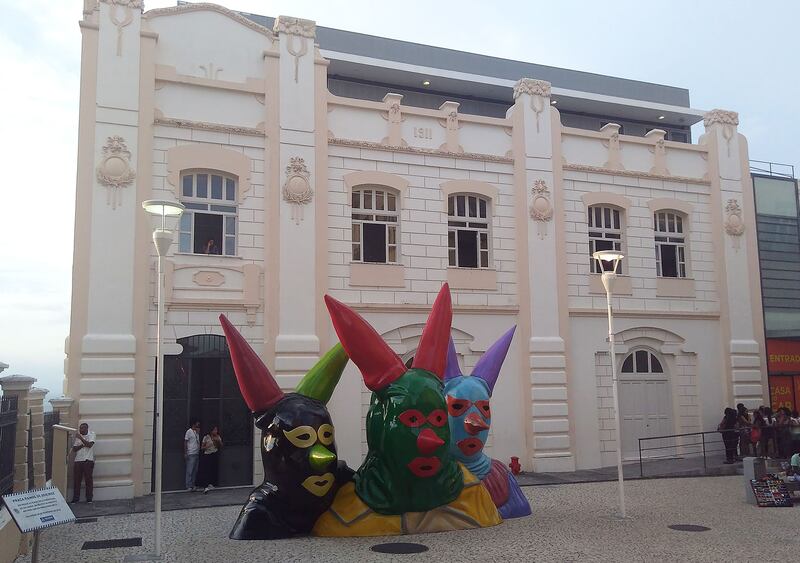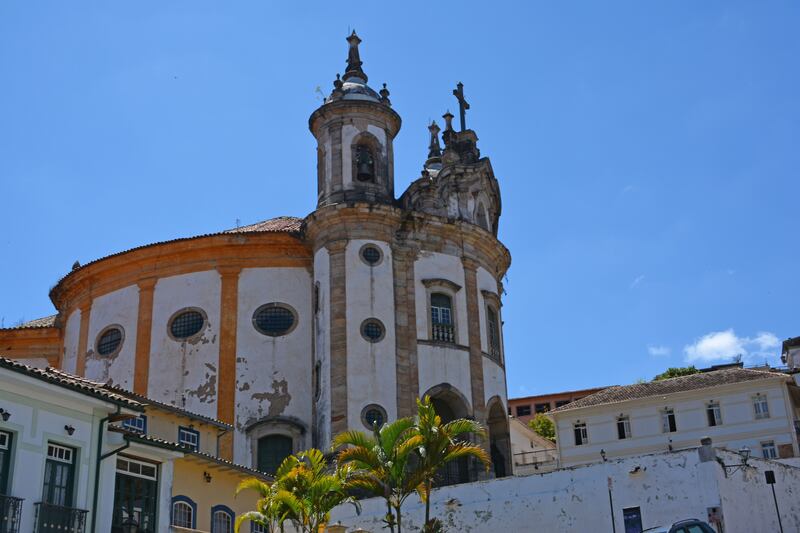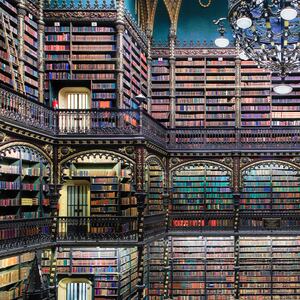The cobblestone streets of Salvador, Brazil’s original capital city, call to mind the Raymond Chandler line that described a particularly dynamite woman: “There are blondes, and then there are blondes.” Sure, there are dozens of cities throughout the Americas with quaint colonial-era architecture. But only a few, a Cartagena or Charleston, fill travelers with such lust for the picturesque that the fetid origins of the cities’ wealth are easily put out of mind.
And then there is Salvador. In the old city, perched on a cliff on a peninsula at the mouth of Brazil’s largest bay, one finds block after bewitching block of pastel-hued buildings done up in the immoderate Portuguese Baroque. Daily doses of sea air and centuries of neglect add a wistfully ramshackle quality to it all.
When gold and diamonds were discovered in Brazil’s interior in the 18th century, the capital was moved to Rio and Salvador’s centrality lessened. Over time, the city was claimed by descendants of the millions brought here in bondage—the people who actually built the city. Now, it’s the epicenter of Afro-Brazilian culture—art, religion, and, especially music. Samba was born here and in the surrounding state of Bahia, and from midday until late in the evening, the city sings and dances.
Salvador can be found in northeast Brazil, a two-hours-and-change flight from Rio or Sao Paulo. The sprawl of the city weaves its way up the peninsula and encompasses more than 4 million people, so traffic from the airport moved at a crawl.
On the way in, we stopped at the Casa di Vina, a hotel and restaurant built around the former home of the poet Vinícius de Moraes, who wrote the lyrics to “The Girl from Ipanema.” In the 1970s, he lived here with his seventh wife, the actress Gessy Gesse, who was a quarter century his junior. The restaurant, which maintains a memorial to Moraes, opens onto a palm-tree-lined pool and the sea across the street. In this relaxed setting, it felt like the right time to dive into Bahian cuisine with moqueca, a fish stew with coconut milk, tomatoes, and peppers. In Bahia it’s usually made with palm oil, which made it heavier than I expected. An already rich dish, this version seemed more so because it was also cooked with plantains.

The historic center of Salvador is a UNESCO World Heritage Site, and at its heart on the square in front of the secretly lavish São Francisco Church is the Hotel Villa Bahia, my home for my stay. Formed by two adjoining mansions, it’s just 17 rooms spread out over a handful of floors. The decoration is restrained but with some flair here and there, an ideal match for travelers who like things to look aged without being run-down. The public spaces are striking—a green-tiled courtyard pool enclosed by arched white stucco walls and a naturally lit, verdant breakfast patio with creaking wooden furniture and a gurgling stone wall fountain.
It’s also reasonable—a suite in the height of tourist season was $250 a night.
Down the hill from the hotel is one of Salvador’s most renowned attractions—the Balé Folclórico da Bahia. Three nights a week in the little Miguel Santana Theater the dancers here put on a 45-minute tour-de-force that showcases regional dances fusing African, Indigenous, and European influences. That first night was my first time getting to see capoeira, a mesmerizing mixture of dance and martial arts, and experience the world of candomblé, a syncretic religion from Bahia that fused religions from West Africa with Christianity. I often have trouble sitting through performances, but found myself so transfixed that suddenly it was over and I was walking down to a parking garage in the shadow of the palace built as a retirement home for Franciscan friars.
My guide for the evening, Conor O’Sullivan of Tatur Turismo, took us to Amado. Located on the waterfront at the edge of Salvador’s mid-facelift commercial district, Amado’s been open nearly two decades yet still ranks atop the best restaurants in Salvador. After eating here you can see why—everything is tasty, the service is fast but with care, and you’re on the water.

The island of Frades.
Carlos Sanchez Pereyra/GettyMy expectations as far as food for Salvador were nonexistent—I had no concept and thus no preconceived notions. Generally, in my four days there I ate at fantastic spots. For lunch on my second day, I dined at Mistura, a glassed-in spot atop the escarpment overlooking the city marina. The husband and wife Paolo Alfonsi and Andréa Ribeiro started it years ago in a tent on the beach, and over time it has morphed into one of the city’s smarter spots. (One tip: their melon and caqui drink is delicious and light.) A true delight was ensconcing myself at sunset on the terrace of Antique Bistro. Here on the ground floor of one of the townhouses that line the western cliff of the city, I gorged myself near to pain on smoked rib balls and tapioca cubes while sipping on a purplish caipirinha made with jabuticaba berries.
The greatest gastronomic experience, and one of the highlights of my entire time in Brazil, happened in a little complex of bungalows on Frades Island. There are 91 islands in the bay here, but the most popular is Frades, which has little towns and beaches and is serviced by a catamaran ferry. (If you can afford to charter a boat for the day, do it. The catamarans are slow and the captain talks the entire time, and you’ll watch as one by one the captive market of passengers succumbs and starts buying drinks to pass the time. Plus, there are quiet and pristine beaches on other parts of the island that you need a boat to access.) On the southern side of the island in Ponta de Nossa Senhora de Guadalupe where the shuttles drop off the crowds, you’ll find Restaurante Preta. It’s run by Angeluci Figueiredo, one of those restaurateurs any city is lucky to have who never stops moving and whose big ideas and passion can bend a city and community toward a better future. Within Preta’s tropical confines, where some guests stretched out on hammocks to sleep, the frenetic pace at which I’d been seeing the city finally slowed.

Casa do Carnaval da Bahia.
Wikimedia CommonsA vacation eating and drinking well in beautiful weather is well and good, but Salvador is also culturally rich. Two museums worth checking out are the Cidade da Musica de Bahia, where you can explore the region’s deep and still innovative musical culture, and the Casa do Carnaval da Bahia. The latter is in Portuguese and English, which is a plus as it’s a nice way to dip one’s toes into what some consider the most over-the-top citywide party in the world—Salvador’s Carnaval. While Rio’s might grab more attention abroad, Salvador’s involves millions of people partying and dancing in the street for days on end. It’s an experience I am not sure I’d ever be able to enjoy given my aversion to crowds, but the videos, displays, and images are excellent at showing how this event is so much more than just a party—it’s a significant cultural event.
The amount of history and culture here can be daunting for those of us without a grounding in Brazilian history. To get my bearings, I took a guided walking tour one morning. We commenced by exploring the aforementioned São Francisco Church, which I said was secretly lavish because while the outside is quite subdued, the interior is decorated with more than one ton of gold, intricately carved jacaranda wood, and one of the world’s largest collection of azulejo tiles. Because the Portuguese were so deeply religious, a lot of the stops are holy in nature.
We took the Lacerda Elevator, which travels 72 meters up and down the cliff. Even 150 years after it opened, it remains one of the world’s most heavily trafficked public lifts. At its base is one of the best examples of Portuguese decoration at the height of its empire—Nossa Senhora Concepcion. At the top, a plaza opens to a once grand boulevard that snakes its way from the historic center through a commercial corridor and past luxury apartment blocks built on what used to be palatial homes that commanded a view of the bay. The part of the boulevard closest to the historic center is undergoing a major revival, often at the hands of prominent hotel chains—the Fasano hotel group restored an old newspaper office into one of its luxurious outposts, and the Rosewood is planning to restore and occupy the stately Palacio Rio Branco.

Igreja de Nossa Senhora do Rosário dos Homens Pretos.
Fred Matos/Getty Images/Fred Matos/GettyWhile it seems nearly every church you see is a “first” of this or that in Brazil, two of the more famous ones were closed when I went to see them. The first was the Igreja da Ordem Terceira do Carmo. I must have taken a few hundred shots of it the first afternoon I arrived and wandered the city. Its doors and windows are framed in elaborately carved lioz stone, a warm material used in royal buildings in Portugal. Inside, though, is one of Brazil’s great religious statues—a carving of Christ by a self-taught Black slave named Francisco Xavier das Chagas (the Carmelites kept slaves). The blood dripping down Christ’s figure is no ordinary red paint. It was made by crushing more than 2,000 rubies in whale oil!
The second church, Igreja Nossa Senhora do Rosário dos Pretos, was the one I was most excited about. The history of this house of worship is intertwined with that of the city’s slaves—it was built for slaves and later became a congregation of former slaves and their descendants. Once a week, the public can attend a Catholic service here that incorporates the music of candomblé.
Crossing those items off would be reason alone to return to this relaxing, fascinating, and beautiful city. But there is so much of Salvador I didn’t get to see. While I went out one night in San Antonio, a historic but less restored part of the city now trendy with young people at night, I didn’t get to spend any time in popular Rio Vermelho. My visit was so packed I also didn’t get to enjoy the water here, whether in the beach neighborhood of Barra or the strips of sand between the neighborhoods of Solar do Unhão and Gamboa de Cima e de Baixo which cling to the cliff underneath the highway along the bay.
All too often our sheeplike way of traveling limits most American trips to Brazil to Rio, São Paulo, and Iguazu—but after this visit, I can’t imagine I’d come back to Brazil without making another stay in Salvador.







